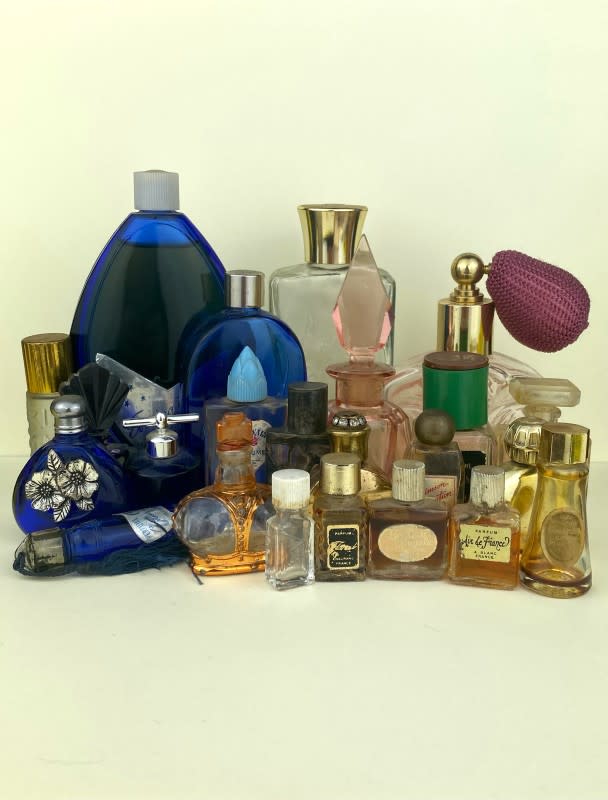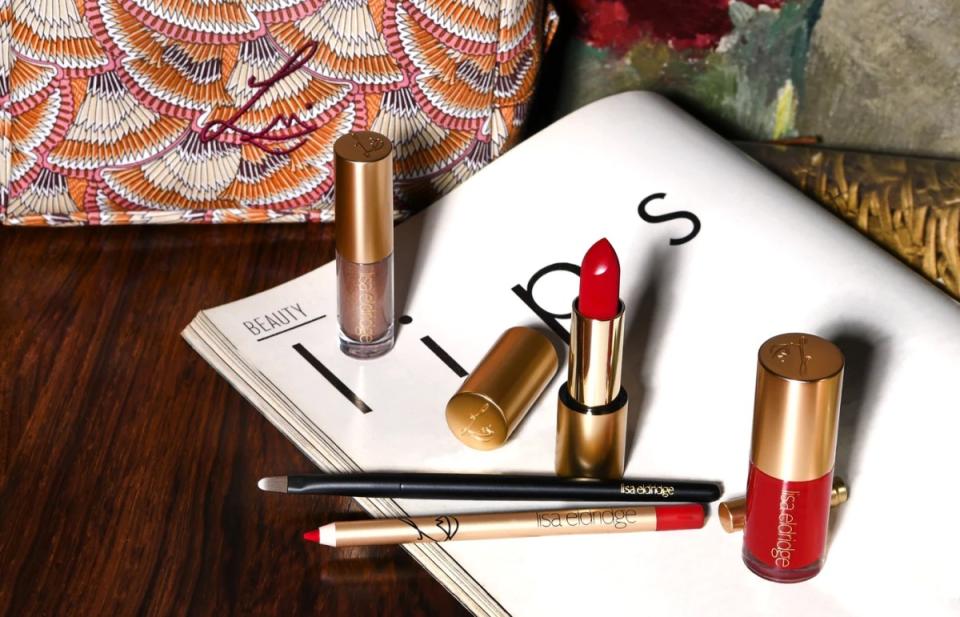The Archivists and Collectors Who Obsess Over Vintage Beauty Products
We're living in a time when brands are churning out new beauty products at a breakneck pace. Microtrends are constantly coming and going, but where most of the industry is fixated on innovation, product development and finding the next big thing, some beauty fanatics are choosing instead to journey back in beauty history.
Across TikTok, Instagram and Youtube, there's a growing movement of vintage beauty collectors who are diving into the archives — as well as Ebay, flea markets and estate sales — to learn more about the history of makeup and collect treasured bygone items along the way. For many, it's also resulted in bigger realizations about quality and sustainability.
Under hashtags like #vintagebeauty and #vintagemakeup, these creators are generating millions of posts discussing old-school muses, history lessons and their incredible collectable finds, like an ornate lipstick tube or an elegant compact filled with long-expired powder. With beauty trends moving faster than you can say "aren't blueberry milk nails just... light blue nails?", it feels like there are now fewer moments than ever to pause and consider the past. That's what these content creators are working to change.
Erin Parsons, a New York-based makeup artist and content creator, is the face of vintage beauty collecting online. Having ostensibly become the go-to creator on the subject for her 2.2 million followers on TikTok, Parsons shares brilliant makeup tips in between posts about MAC lipsticks from the '80s, vintage Lancôme perfumes and her fascination with one iconic blonde bombshell.
"I think I was six years old when I first discovered Marilyn Monroe," Parsons tells Fashionista. "It was the search for her actual makeup products that got me into vintage makeup. It opened up an entirely new world for me."
This sparked Parsons' passion as a vintage collector and her never-ending search for Monroe's makeup. (She's since bought some of the star's cosmetics, but remains on the hunt for her iconic red lipstick.) Her first vintage purchase was a tube of Maybelline Cake Mascara. "I was searching for this product and I found it on eBay. Unfortunately it was used and stinky, so I learned quickly to always buy unused products in mint condition, and if possible new in the box," she says.
The stars aligned when she signed on as Maybelline's global makeup artist in 2017. Parsons admits that when she joined the company, "I wanted to find the original mascara created in 1916. That led me on such a deep dive and now I have every product up until they sold the company in the '70s."
Admittedly, it's a pretty expensive hobby, one that's been central to her life for seven years now, but the treasures found along the way have been worth it. In her collection, Parsons has opera glasses with a hidden compartment in the eyes for lipstick and a powder puff, as well as Revlon Futurama lipsticks from the '50s, which she says she wishes they'd kept producing.
Part of the charm of collecting vintage beauty is undoubtedly the novelty of it all. "The weirdest item in my collections are '60s and '70s-era Avon compacts," Scarlett Babcock, a vintage dealer based in Stockton, California tells Fashionista. "They were so kitschy and goofy, I wish I had more. I own one that is a giant penny that once held two shades of lip gloss."

Photo: Courtesy of Scarlett Babcock
Babcock started her collection with a '20s dancing purse, which she found at a flea market. "It's made of metal and hangs from a ring and chain so that it could be held in your hand while you dance all night. It holds face powder, rouge and a mini lipstick. The metal cap of the lipstick is engraved with topless hula girls dancing," she says. The unbranded compact is marked with a patent date of Oct. 5, 1926, while the mini lipsticks are made by a brand called Tattoo, which has become Babcock's white whale: "They are pricey but I really hope to find a full-sized version of the lipsticks someday."
An overarching theme for these collectors is that, whether they're focused on vintage makeup, perfumes or compacts, most of the time, it isn't about the formulas inside at all — they're interested in the packaging.
"I love that a lot of vintage cosmetics came in gorgeous, ornate brass cases which could be reused over and over," explains Anastasia Marie, a vintage seller based in Ferndale, Michigan. Marie, who's obsessed with all things vintage, is understandably enamored with how previous eras' makeup packaging was designed both with form and function in mind — as accessories and keepsakes rather than disposable toiletries. "Not many makeup companies do that nowadays," she says. "It would be nice to be able to buy one luxurious case or one fancy perfume bottle and be able to purchase refills."
The low-waste functionality of so many vintage beauty items brings up current discussions of sustainability, particularly as the modern industry grapples with how to reduce its massive carbon footprint and cut down on its notoriously wasteful practices.
Zero Waste Week data states that, on average, more than 120 billion units of cosmetics packaging is currently being produced globally each year. A study by Netherlands-based group LCA Centre found that if refillable containers were used, up to 70% of carbon emissions associated with the beauty industry could be eliminated.
We often don't look to the past when considering solutions for the future, but the glaring truth is that, in many consumer-facing ways, cosmetics production and packaging seem to have had more sustainable practices in the '20s and '30s than it does today.


New Zealand-born, English-based makeup artist Lisa Eldridge, a major name in the industry who serves as the global creative director of Lancôme, is one of the most renowned vintage cosmetic collectors in the world. In a YouTube video from 12 years ago, Eldridge fawns over some of her favorite items, from deco powder compacts to makeup palettes with built-in cigarette compartments. In this same video, she even tries on some of the blush and, in another, she creates full-face looks using vintage cosmetics that are more than 50 years old. (Although she does caution that the general public shouldn't be using expired makeup.)
Eldridge is struck by the longevity of the formulas. "It's so interesting how sustainable the pieces are and how incredibly well they've lasted," she says. "Some of the pieces I own are over 100 years old and they look like they could be new."
Her collection includes things like Audrey Hepburn's bejeweled '50s Cartier lipstick holder, "tatty and clearly-worn false lashes from the '30s," and "Poudre Tho-radia," a '30s-era radioactive face powder from a French purveyor of radioactive cosmetics, Tho-Radia.
"It may seem pretty unthinkable that anyone would sell, let alone buy, a radioactive powder today," says Eldridge. "But when radium was first discovered by Marie and Pierre Curie in 1896, there were no regulations in place to control the safety of new beauty products, or ensure they were tested before they were released."
Captivating tidbits like this are often imparted by collectors like Eldridge and Parsons, whose vintage collecting may have started with aesthetic motivations, but quickly developed into an obsession with the history and lore surrounding it.
And one thing that all the collectors Fashionista spoke with for this story brought up was that history has a habit of repeating itself.
"There has been a 'clean-girl' era every decade," Parsons quips. "There has been talk of 'clean' and 'non-toxic' beauty products as far back as centuries ago. What you often see is a change based on major events in history – makeup and beauty responds to it," she explains. She points to how, after the pandemic, there was a decline in the full-coverage looks that swept 2016. "[Similarly] in the '40s we saw a shift because of the war…the history books give a huge insight into changes of beauty trends."

Mako Bayramyan is another creator taking a leaf out of the history books, but to share some tenets with others. "Craftsmanship and attention to detail in product and packaging has definitely been lost over time," she laments. "That's what drove me to create Glamour Lipsticks."
She's referring to her brand, Vulox Vanity, a moniker which she also uses on TikTok to share her vintage finds. The creamy, semi-matte, long-wear lipstick line that Bayramyan has created is a veritable love letter to her hobby, but with an eye to the future. Fluted gold metal casing, packaged in a box that resembles an elegant cigarette carton, was all thoughtfully perfected over two years. "I wanted to create a product that not only has a great formula but looks beautiful enough to display on your vanity," she says.
In a similar spirit, Eldridge's eponymous makeup line touts elegant gold finishes and nods to vintage collections. Both brands' packaging carries a spirit of permanence, of wanting to serve as a vanity keepsake rather than being discarded and forgotten in favor of the next big thing.

Photo: Courtesy of Lisa Eldridge
So it's worth asking: What if more brands in the industry followed suit, drawing their inspiration more from the quality and design achievements of the past, rather than being so fixated on creating the newest fad? What if they dared to envision a world in which beauty consumers weren't driven primarily by ephemeral trends that filled their drawers with plastic containers, cheap metallic paint instead of real metal, and flimsy compacts that break with the slightest of falls?
Perhaps there would be a bit more room to savor the creativity and sentimentality of beauty products if this were the case. Cosmetics are among the most personal of consumer purchases, after all. While some innovation is obviously good — the development of cleaner, non-radioactive formulas for, instance — maybe it's time for history to repeat itself again, this time for the better.
Want the latest fashion industry news first? Sign up for our daily newsletter.


